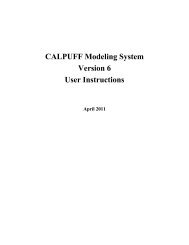Volume 1 - The Atmospheric Studies Group at TRC
Volume 1 - The Atmospheric Studies Group at TRC
Volume 1 - The Atmospheric Studies Group at TRC
You also want an ePaper? Increase the reach of your titles
YUMPU automatically turns print PDFs into web optimized ePapers that Google loves.
All sampler loc<strong>at</strong>ions are used as receptors, but additional ones are added to increase<br />
the density of receptor spacing along the shoreline. Intermedi<strong>at</strong>e receptors are placed<br />
<strong>at</strong> approxim<strong>at</strong>ely 50m intervals, with elev<strong>at</strong>ions interpol<strong>at</strong>ed from the actual sampler<br />
elev<strong>at</strong>ions. In this case, all elev<strong>at</strong>ions are 1.5m MSL. A total of 380 receptors are<br />
used in the CALPUFF modeling.<br />
Meteorological Processing<br />
Meteorological d<strong>at</strong>a files for applying CALMET/CALPUFF to the Cameron study<br />
are developed primarily from files used to run OCD4. <strong>The</strong> “release” meteorology<br />
identified for OCD4 is used to construct represent<strong>at</strong>ive SEA.DAT (over w<strong>at</strong>er) and<br />
SURF.DAT (over land) input files for CALMET. Cloud observ<strong>at</strong>ions made <strong>at</strong> the<br />
Cameron shoreline during the study are included in the SURF.DAT file. <strong>The</strong><br />
SEA.DAT st<strong>at</strong>ion is placed <strong>at</strong> Pl<strong>at</strong>form 28A, while the SURF.DAT st<strong>at</strong>ion is placed<br />
onshore <strong>at</strong> (480, 3295).<br />
<strong>The</strong> original OCD4 evalu<strong>at</strong>ion files indic<strong>at</strong>e th<strong>at</strong> air temper<strong>at</strong>ure and wind speed are<br />
measured <strong>at</strong> 18m for all of the hours. This is true most of the time, but there are<br />
periods when d<strong>at</strong>a from 10m <strong>at</strong> the shoreline mast are substituted for the 18m d<strong>at</strong>a <strong>at</strong><br />
Pl<strong>at</strong>form 28A. This occurs on:<br />
Temper<strong>at</strong>ure <strong>at</strong> 10m<br />
7/**/1981 all hours (pl<strong>at</strong>form did not measure air temper<strong>at</strong>ure in July)<br />
2/15/1982 all hours<br />
2/17/1982 1300-1400<br />
2/23/1982 1000-1100<br />
Wind Speed <strong>at</strong> 10m<br />
7/20/1981 all hours<br />
2/15/1982 all hours<br />
2/17/1982 1300-1400<br />
<strong>The</strong> anemometer height associ<strong>at</strong>ed with the SURF.DAT wind d<strong>at</strong>a during these<br />
periods is set to 10m. Because CALMET accepts a single measurement height for the<br />
speed and temper<strong>at</strong>ure in the SEA.DAT file, th<strong>at</strong> height is reset to 10m whenever the<br />
temper<strong>at</strong>ure measurement height is 10m. Wind speed is profiled from the actual<br />
anemometer height to the temper<strong>at</strong>ure measurement height when these are different.<br />
Boundary layer parameters computed by OCD are used with Monin-Obukhov<br />
similarity profiles to compute the wind speed adjustment.<br />
Wind directions used in the OCD4 d<strong>at</strong>asets are those th<strong>at</strong> align the source and the<br />
sampler with the peak concentr<strong>at</strong>ion each hour. This allows the evalu<strong>at</strong>ion to focus<br />
Final Report Vol.1 29







